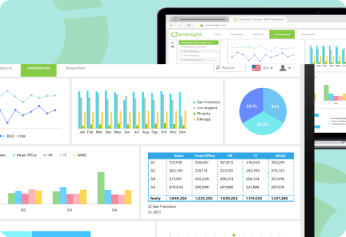What is a Flexible Budget?
A flexible budget is a dynamic financial plan that adjusts based on changes in activity levels or output, providing a realistic and actionable approach to financial management. Unlike a static budget that remains fixed regardless of operational changes, a flexible budget aligns costs and expenses with actual business activity. This adaptability offers businesses a clearer understanding of their financial performance and the ability to respond to changing circumstances.
For example, imagine a manufacturing company where the cost of producing each unit decreases as production volumes increase due to economies of scale. A flexible budget would reflect these changing costs, offering a more accurate representation of financial performance and helping the company make better-informed decisions.
Flexible Budget vs. Static Budget
The primary distinction between flexible and static budgets lies in their adaptability. A static budget remains fixed throughout the budget period, regardless of actual activity levels, while a flexible budget adjusts to reflect real-time changes.
|
Feature |
Static Budget |
Flexible Budget |
|
Adjusts with activity |
No |
Yes |
|
Accuracy |
Limited |
High |
|
Complexity |
Low |
Medium to High |
|
Use Case |
Predictable scenarios |
Dynamic environments |
Static budgets are suitable for organizations operating in stable conditions, whereas flexible budgets are essential for businesses experiencing fluctuating activity levels or unpredictable expenses.
Example of a Flexible Budget in Action
Imagine a coffee shop that initially sets a static monthly budget of $10,000. After launching a successful marketing campaign, customer traffic surges, increasing supply and labor costs. A flexible budget adjusts to this higher activity level:
|
Expense |
Static Budget |
Flexible Budget (3,000 customers) |
|
Coffee Supplies ($2/customer) |
$2,000 |
$6,000 |
|
Labor Costs |
$3,000 |
$3,500 |
|
Rent & Utilities |
$2,000 |
$2,000 |
|
Marketing |
$1,000 |
$1,000 |
|
Miscellaneous |
$1,000 |
$1,000 |
|
Total |
$10,000 |
$13,500 |
This adjustment allows the coffee shop to plan effectively, optimize resources, and capitalize on increased revenue opportunities during peak periods.
Types of Flexible Budgets
1. Basic Flexible Budget
This type of flexible budget focuses only on costs that vary directly with revenue. It is the simplest and quickest to prepare. For instance, a retail store might create a basic flexible budget where costs like inventory and sales commissions are adjusted based on revenue fluctuations.
While straightforward, it has limitations because it doesn’t account for indirect or overhead costs. However, it serves as a foundational tool for small businesses or organizations with fewer variable cost components.
2. Intermediate Flexible Budget
An intermediate flexible budget expands on the basic model by including additional variable costs that don’t directly correlate with revenue but still fluctuate based on business activity. For example, employee benefits or facility maintenance costs might be included here.
This type of budget provides a more comprehensive view of financial performance by considering factors beyond immediate revenue changes. It’s ideal for mid-sized organizations with diverse operations.
3. Advanced Flexible Budget
The advanced flexible budget is the most detailed and sophisticated. It accounts for all variable and fixed costs, creating a highly accurate and adaptive financial plan. This type of budget incorporates changes across all areas of the business, including labor, materials, overhead, and even strategic investments.
Though time-intensive to prepare, an advanced flexible budget provides the most precise insight into financial performance. It is best suited for large organizations or businesses operating in highly volatile environments. Tools like Limelight FP&A are indispensable for managing the complexity of advanced flexible budgets.
Steps to Create a Flexible Budget with Limelight FP&A
Creating a flexible budget can seem daunting, but Limelight FP&A simplifies the process. Here are the detailed steps:
1. Identify Key Business Drivers: Determine the primary factors influencing your costs and revenue. Common drivers include sales volume, production levels, and customer demand. Accurately identifying these drivers ensures your budget aligns with real business dynamics.
2. Categorize Costs: Divide costs into fixed and variable categories. Fixed costs, like rent or salaries, remain unchanged regardless of activity levels, while variable costs, such as raw materials or utilities, fluctuate. This distinction is crucial for building an adaptive budget.
3. Define Activity Levels: Establish activity scenarios such as low, medium, and high levels of sales or production. Use historical data and market research to set realistic ranges for these levels.
4. Leverage Limelight Templates: Input your categorized costs and activity levels into Limelight’s pre-built templates. These templates are designed to handle complex calculations and ensure accuracy. Limelight automates many of the repetitive tasks, saving time and reducing errors.
5. Run Scenarios and Analyze Results: Use Limelight’s scenario planning tools to simulate different outcomes. Compare the results to identify potential risks and opportunities. This helps you prepare for various business conditions and ensures your budget is both realistic and actionable.
6. Monitor and Adjust: As the budget period progresses, track actual results against your flexible budget using Limelight’s real-time variance analysis. If significant deviations occur, adjust your budget to reflect new information. This ensures your financial plan stays relevant and useful.
Advantages of a Flexible Budget with Limelight
Improved Accuracy: A flexible budget reflects changes in activity levels, providing a more accurate picture of financial performance. Limelight’s automated calculations ensure that adjustments are precise and based on real-time data.
Enhanced Decision-Making: By accounting for variability, a flexible budget enables businesses to make informed decisions quickly. Limelight’s scenario planning tools further enhance this capability by allowing businesses to explore potential outcomes.
Streamlined Collaboration: Budgeting often involves input from multiple departments. Limelight’s collaborative platform ensures that teams can work together seamlessly, reducing miscommunication and improving overall alignment.
Time Efficiency: Manual adjustments to budgets can be time-consuming and error-prone. Limelight automates these processes, freeing up time for strategic analysis and planning.
Proactive Planning: Limelight’s ability to model different scenarios helps businesses prepare for uncertainties, ensuring they are ready to capitalize on opportunities or mitigate risks.
Challenges and Solutions
Common Challenges:
- Complexity: Flexible budgets can be challenging to create manually, especially for businesses with multiple variable costs.
- Time-Consuming: Gathering data and updating budgets frequently can strain resources.
- Comparability Issues: Analyzing results across various activity levels requires detailed and often intricate calculations.
Limelight’s Solutions:
- Automation: Limelight simplifies data collection and calculations, significantly reducing complexity.
- Visualization Tools: Intuitive dashboards and reports make it easier to compare results and identify trends.
- Pre-Built Templates: These templates streamline the budgeting process, ensuring consistency and accuracy.
How Limelight FP&A Enhances Flexible Budgeting?
Limelight FP&A elevates the flexible budgeting process with advanced automation, real-time data integration, and insightful analysis tools. By leveraging Limelight, businesses can transform a complex task into an efficient and effective strategy. Here's how:
See Limelight in action:
1. Automated Data Integration
Limelight integrates seamlessly with leading ERP systems like NetSuite, QuickBooks, Microsoft Dynamics, and SAP. This ensures that your budgets are always based on the most current data, reducing errors and saving time.
2. Scenario Planning Tools
Limelight enables you to create and compare multiple "what-if" scenarios, helping you model the financial impact of varying activity levels. This feature prepares businesses to navigate uncertainties and make proactive adjustments.
3. Customizable Templates
With industry-specific templates, Limelight simplifies the creation of flexible budgets tailored to your unique business needs. These templates ensure that all critical components are accounted for, allowing for rapid deployment.
4. Collaborative Platform
Budgets often require input from various departments. Limelight’s collaborative tools enable teams to work together in real-time, improving accuracy and alignment across the organization.
5. Real-Time Variance Analysis
One of Limelight’s standout features is its ability to track and analyze variances in real-time. Businesses can compare actual performance against budgeted figures, identify deviations, and implement corrective actions without delay.
6. Enhanced Forecasting
Limelight’s advanced forecasting tools make it easy to update flexible budgets as new data becomes available. This ensures that your budgets remain relevant and actionable throughout the reporting period.
Why Choose Limelight FP&A for Flexible Budgeting?
Limelight FP&A is designed to make flexible budgeting accessible, efficient, and insightful. Its combination of automation, collaboration, and advanced analytics empowers businesses to adapt quickly to changes, optimize resources, and make data-driven decisions. Whether you’re navigating market fluctuations or planning for future growth, Limelight ensures your budgets remain a reliable tool for success.
Ready to transform your budgeting process? Learn more about how Limelight FP&A can help your business stay agile and achieve its financial goals.
Table of Contents
Ready to put an end to outdated FP&A?
Get a perzonalized demo





